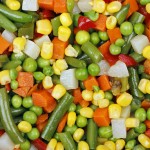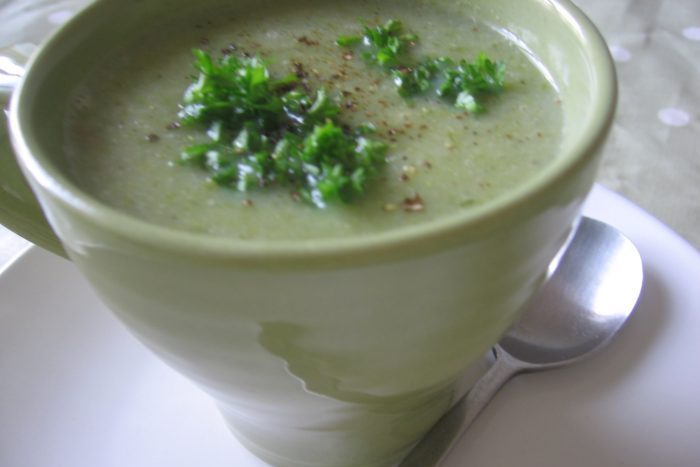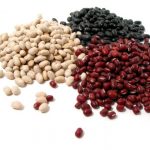Leftover lettuce, spring onions and potatoes transformed into a tasty soup.
You can replace the lettuce with other vegetables like carrots, broccoli & cauliflower, cooked or raw, if that’s what you’ve got leftover! And if you’ve got some spare bread that’s past its best; brush with olive oil, bake until crisp and cut into croutons.
Skills Check
Follow a recipe; follow food safety & hygiene rules; tidy away; use weighing scales; use measuring spoons; use a jug to measure liquids; cut using bridge/claw technique safely; snip herbs with scissors; use a tin opener safely; use a hob (with adult supervision); use a colander/sieve; season to taste.
Equipment
Saucepan, wooden spoon, chopping board, knife, can opener, weighing scales, scissors, small bowl, sieve/colander, measuring spoons, kettle, measuring jug, hand blender, baking tray, pastry brush.
Allergens (Please note the allergens listed above are indicative only. Allergens vary depending on brand; check the labels on the products you use)
Gluten | Celery | Sulphites
Ingredients (serves 2):
- 2 tsp olive oil
- 1/2 bunch spring onions, washed and sliced thinly
- 2 medium-sized new potatoes, scrubbed and chopped
- 1/2 large lettuce, shredded and washed
- 1/2 tsp dried herbs
- 250 ml reduced salt vegetable stock
- 80 g frozen sweetcorn
- 200 g borlotti beans, canned and drained
- 1 tbsp balsamic vinegar
- Black pepper, to taste
- Any fresh herbs, washed and snipped to garnish (optional)
- 1 slice of bread (optional)
- 1 tsp olive oil (optional)
Method
- Preheat the oven to 180°C / gas mark 5 (if making croutons).
Gently heat 2 tsp olive oil in a saucepan then add the spring onions and fry gently for about 5 minutes, stirring regularly. - Add the potatoes and lettuce and cook for another few minutes.
Add the stock to the saucepan along with the dried herbs and stir well. - Bring to the boil then turn the heat down and simmer gently until the potatoes are tender - around 10 minutes.
- (Optional) While the soup is cooking, make the croutons by brushing the bread with oil and baking in the oven for about 10 minutes until crisp. Cut the baked bread into small chunks.
- Remove the pan from the heat and use the hand-held blender to blitz until smooth.
- Stir in the sweetcorn and beans and put the pan back on the stove. Simmer for a further 5 minutes.
- Add the balsamic vinegar, and freshly ground black pepper to taste.
- Divide between bowls and sprinkle with chopped fresh herbs and croutons (if using).
So thinking about Summer garden soup ...

Beans of all types are fantastically healthy! Low in fat, sugar and calories and high in protein, B vitamins and fibre.
Potatoes are very nutritious and low in calories. If eaten with the skin on they are high in complex carbohydrates and fibre. They are also a good source of vitamin C and B6, as well as a range of minerals.
Nutritional Information
| - | Energy | 951kJ / 227kcal | 11% |
| Low | Fat | 5.8g | 8% |
| Low | Saturates | 1.0g | 5% |
| Low | Sugars | 6.4g | 7% |
| Low | Salt | 0.7g | 11% |
per 363g serving
% of an adult's reference intake
Typical values per 100g: Energy 262kJ / 62kcal
Notes
A traffic light system is used on nutrition labels to make it easier to see which foods and drinks are lower in calories, fat, sugar and salt. Try and choose more ‘greens’ and ‘ambers’ and fewer ‘reds’, and stick to smaller portions of ‘reds’.
Just because a recipe or a food has a red traffic light doesn’t mean you shouldn’t eat it. Understanding why a food or recipe might have a red light can be helpful. For example oily fish is high in total fat and so any recipe containing oily fish is likely to be ‘red’ for fat. But it is recommended that we eat oily fish at least once a week because the type of fat it contains is beneficial for our health.
% Reference Intakes are also shown. Reference Intakes are guidelines about the approximate amount of particular nutrients and energy required for a healthy diet (based on an average-sized woman doing an average amount of physical activity). Most children will require less than these Reference Intakes. The contribution of one serving of a food or drink to the Reference Intake for each nutrient is expressed as a percentage.




